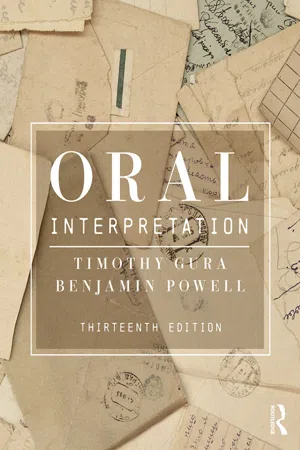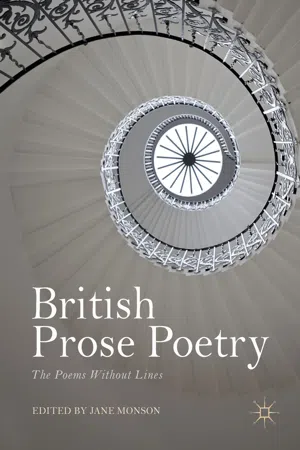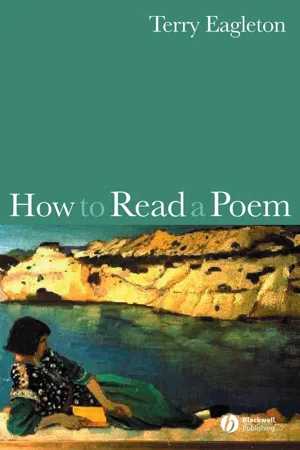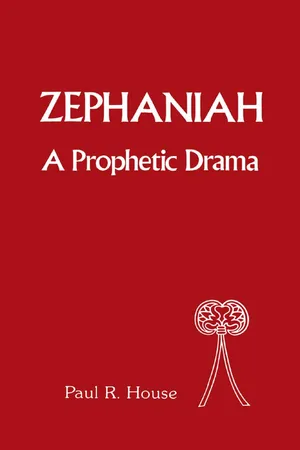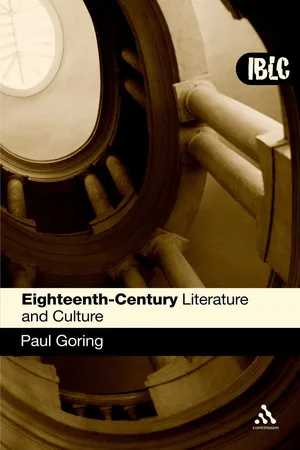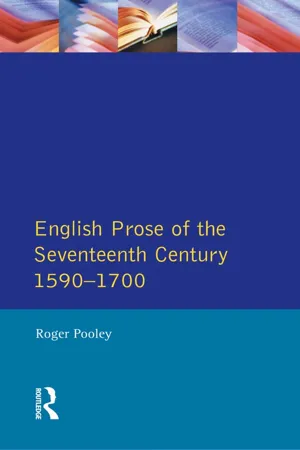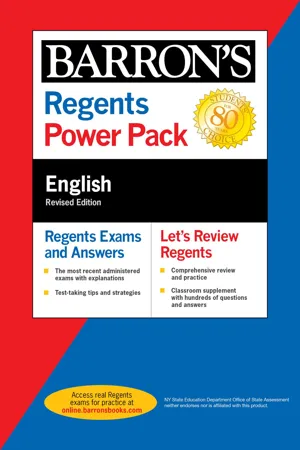Literature
Prose
Prose refers to written or spoken language that follows natural speech patterns and does not adhere to a specific metrical structure, as opposed to poetry. It is the most common form of written language and encompasses a wide range of literary works, including novels, short stories, essays, and non-fiction. Prose allows for more flexibility in expression and storytelling compared to poetry.
Written by Perlego with AI-assistance
Related key terms
1 of 5
10 Key excerpts on "Prose"
- eBook - PDF
Practicing Literary Theory in the Middle Ages
Ethics and the Mixed Form in Chaucer, Gower, Usk, and Hoccleve
- Eleanor Johnson(Author)
- 2013(Publication Date)
- University of Chicago Press(Publisher)
Theories of Prose understand it as a written reflection of a spoken form. 22 But, cru-cially, they understand that written reflection of speech as representable by specific formal conventions—prosaic “feet.” In practice, this assertion has tremendous consequences for the evolution of literary Prose, both in Latin and in Chaucer’s Middle English Boece . John of Garland takes the idea that Prose obeys certain formal con-straints further, noting that spoken utterances—the putative bases of Prose composition—are formally organized into clauses: “Dicatur quid sit prosa. Prosa est sermo sentenciosus ornato sine metro compositus, distinc-tus clausularum debitis intervallis.” 23 (Let it be said what Prose is. Prose is sententious speech, composed without metrical ornamentation, distin-guished by the necessary intervals of clausules.) Like meter, Prose is “com-posed” and “ornate”; the difference is that the fundamental formal units of Prose are “clausules”—units of sense and syntax—rather than metri-cal feet. Prose “feet,” determined by the “natural course of utterance,” are delimited by syntax. The theory of formal, Latin Prose is that the basic formal unit of Prose, the clause, is “necessary,” because it is determined by syntax—the formal representation of the natural course of spoken ut-terance—rather than by the artificial constraints of meter. Since Prose’s fundamental unit is syntactic, it is theorized as the form that thought nat-urally takes when enfolded into language. What the dictaminists do with the notion that Prose is free from meter and hence free to encapsulate ideation clearly and without fetters, how-ever, is quite different from what the Wycliffites and historiographers do. 21. Bernard of Silvester, introduction to “Il ‘Dictamen,’” 194. 22. Mueller, Native Tongue and the Word , 1, 5, 7–8. 23. John of Garland, Parisiana poetria , 4. - eBook - ePub
- Timothy Gura, Benjamin Powell(Authors)
- 2018(Publication Date)
- Routledge(Publisher)
Part I , we discussed how to analyze stories and poems and, then, how to apply that analysis to build performances which embody and evoke the complexities we discovered. The techniques we explored could be used with all types of writing. So, equipped with those critical tools, we looked at how the voice and body could be trained to respond to the major challenges performing presents. That study constructed the foundation on which we now can develop a much more sophisticated exploration.Literature shares many common aspects, of course, but different modes boast distinctive characteristics. For example, you encounter different personas in stories, in plays, and in poems—but drama capitalizes on the interaction of characters. Likewise, you can find narrators or storytellers in poems and plays, but they are the essential figures in Prose fiction. We explore these unique challenges arising from various kinds of literature in the next three parts: Part II concerns Prose, Part III examines drama, and Part IV delves into poetry.We are interested in communicating literature to listeners. An interpreter soon discovers the problems and advantages in each type of literature and then goes beyond this generalization to the specific, individual variations within a particular selection. Regardless of its form or type, each selection should be approached as an individual example. Before we consider the various kinds of Prose, we review some aspects of literary style found in all Prose writing. We focus here on nondramatic Prose.Nondramatic Prose can take many forms: an encyclopedia, a user’s manual for your DVD player, a personal essay, a blog entry, a tweet, a letter, a Facebook post, an oral history, this textbook. Such diverse examples share some important characteristics, and for the interpreter none is more instructive for performance than “style.” After reviewing the general topic of style, we focus on increasingly narrow components in more and more detail. Starting with the role of paragraphs, we drill down to sentences (those things that paragraphs are made of), zero in on speech phrases (what sentences themselves are made of), and conclude with words themselves: why they are chosen (diction), how they sound (tone color), how they live with neighboring words (rhythm - eBook - ePub
British Prose Poetry
The Poems Without Lines
- Jane Monson(Author)
- 2018(Publication Date)
- Palgrave Macmillan(Publisher)
6 So, ‘poetry’ in Prose implies writing in Prose form that incorporates the qualities of poetry: ‘direct language’ with ‘arrest[ing]’ images (Hulme); a dynamic, energized and relational take on the ‘world’ (Binyon).Of course, these were not the only re-definitions. Another way to understand differences among definitions is to separate the camps redefining ‘poetry’ according to the other art form that would serve as model: music (emphasis on rhythm, metricality, recalling Pater’s ‘All art constantly aspires towards the condition of music’ from The School of Giorgione ) or painting (emphasis on image and picture). Undoubtedly, such a division risks oversimplification. After all, even Ezra Pound ’s ‘A Few Don’ts by an Imagiste’ in Poetry (March 1913) addresses both image and rhythm, or, as F.S. Flint summarizes in the essay that precedes Pound’s in the volume: ‘Direct treatment of the “thing,” whether subjective or objective’, and ‘As regarding rhythm: to compose in sequence of the musical phrase, not in sequence of a metronome.’7 But, for some practitioners and critics, the musicality of poetic Prose was definitional as opposed to an unmediated presentation of modern life. The American poet Amy Lowell ’s ‘polyphonic Prose’ is a case in point. In ‘Miss Lowell’s Discovery: Polyphonic Prose’, John Gould Fletcher praises the ‘orchestral quality’ of her work, concluding that ‘it seems fitting that a new name should be given to these poems of hers, which, printed as Prose, or as Prose and verse interspersed, display all the colors of the chromatic palette.’8 Other critics were less convinced; Harriet Monroe, in reviewing the second Imagist collection, Some Imagist Poets —An Anthology , remarks that ‘Miss Lowell’s “polyphonic Prose” in The Bombardment remains for me scientific and artificial, an interesting experiment rather than a new poetic form.’9 Lowell herself attempts distinctions, noting that ‘it is the fashion today to call everything which is without metre vers libre .’ She answers any confusion of verse and Prose (of which Fletcher’s remark is an instance) with such a metrical approach, mapping a spectrum of rhythmic distinctions with ‘pure Prose and pure poetry’ as the extremes, and ‘metrical Prose’ and ‘vers libre’ as ‘steps’ in between.10 In the end, her divisions are at best tendencies: ‘Now as Prose is a long curve with very little return, and poetry is a much shorter curve with a very sharp return; so metrical Prose may be considered as a slightly more curved line than is usual in Prose, with a return beginning to be felt, and vers libre as curving still more markedly, and the return becoming pronounced.’11 T.S. Eliot, in ‘The Borderline of Prose’, takes a similar tack in criticizing Richard Aldington ’s Prose poems as failures in that they incorporate both Prose and verse rhythms. Eliot quotes a passage from a Prose poem by Aldington, then critiques the opening phrases: ‘For my sake Eos, in a cloudless sky, gliding from the many-isled sea, must be more tender and more thrilling.’ Eliot objects to the difference between the verse rhythms of ‘For my sake Eos, in a cloudless sky, gliding from the many-isled sea’ and the Prose of ‘must be more tender and more thrilling.’ Eliot’s distinctions are even less defined than Lowell’s; he simply labels what are Prose rhythms and what are verse to his ear.12 - eBook - PDF
- Agnieszka Miksza(Author)
- 2020(Publication Date)
- Peter Lang Group(Publisher)
1.2 The Prose Poem and the British Tradition The Prose poem is a rather rare phenomenon in English before the 1960s (Murphy 12). The paucity of Prose poems in English, compared to their French counterparts, can be accounted for by differences in versification codes, these being very strict in French, far more so than in English. S. Monte in his book Invisible Fences: Prose Poetry as a Genre in French and American Literature (2000) notes that the origin of the term “Prose poem” dates back to the beginning of the eighteenth century (16). He quotes Cervantes, who famously admitted “the epic may be written in Prose as well as verse”. Monte also suspects the existence of Prose poem in critical works such as Longinus’s “On the Sublime” since this essay underlines the importance of the impact of literature on the reader and Between Poetry and Prose: Genres of the Middle 20 diminishes the significance of the form. Analyzing the history of Literature, Monte arrives at the conclusion that even the selected works of Aristotle may be read as Prose poems. Monte chooses the abovementioned works to highlight the arbitrariness of the division into poetry and Prose. However, his later musings are focused on the modern version of Prose poems. Based on an analysis of numerous publications, Monte concludes that “it is a form that somehow captures, or attempts to capture, a particularly modern experience”. He also won- ders about the connections between historical development and the appearance of the Prose poem, concluding that the link between the two is not particularly strong, and historical events were leaning towards the rise of the novel rather than Prose poetry. In this sense, it seems that the key reason for emergence of the Prose poem lies in bourgeois aesthetics which this genre came up against (Monte 16–17). Monte also quotes Wordsworth, who assumes that “there neither is, nor can be, any essential difference between the language of Prose and met- rical composition” (17). - eBook - PDF
- Terry Eagleton(Author)
- 2011(Publication Date)
- Wiley-Blackwell(Publisher)
Chapter 2 What is Poetry? 2.1 Poetry and Prose A poem is a fictional, verbally inventive moral statement in which it is the author, rather than the printer or word processor, who decides where the lines should end. This dreary-sounding definition, unpoetic to a fault, may well turn out to be the best we can do. Before we dissect it piece by piece, however, let us note what it doesn’t say, rather than what it does. To begin with, it makes no reference to rhyme, metre, rhythm, imagery, diction, or symbolism and so on. This is because there are plenty of poems which do not use these things, and quite a lot of Prose that does. Prose may use internal rhymes, and quite commonly raids the resources of rhythm, imagery, symbolism, word-music, figures of speech, heightened language and the like. Wallace Stevens is rhythmical, but so is Marcel Proust. Virginia Woolf ’s Prose is much more metaphorically charged than John Dryden’s poetry, not to mention Gregory Corso’s. There is more rhetorically heightened language in Joseph Conrad than there is in Philip Larkin. It is true that Prose does not generally use metre. On the whole, metre, like end-rhymes, is peculiar to poetry; but it can hardly be of its essence, since so many poems survive quite well without it. We are left, then, with line-endings, which the poet herself gets to decide on. Even this is only true up to a point: a particular kind of metre may itself determine where the lines have to end. But the poet gets to choose the metre, at least within certain constraints. A dramatist writing around 1600 was normally expected to use blank verse, while a satirist writing around 1750 would probably find heroic couplets the most appropriate form. 25 Line-endings in poetry may not always signify, but they can always be made to. They can even act as a kind of image, of the kind F. R. Leavis discerns in these lines from John Keats’s ode ‘To Autumn’: And sometimes like a gleaner thou dost keep Steady thy laden head across a brook . - eBook - PDF
Zephaniah
A Prophetic Drama
- Paul R. House(Author)
- 1988(Publication Date)
- Sheffield Academic Press(Publisher)
As could be expected from its syntactical characteristics, Prose is linear in aim. That is, its story line will usually move from a fixed starting point to a definite conclusion. Whether the life of an individual, tribe, or nation is described, Prose includes a beginning, middle, and end. Commentary on why the action proceeded as it did is often included, but is always based on the action itself. Prose is therefore objective in purpose and best suited to story. Prose narrative is in no way simplistic, as Robert Alter has conclusively shown. Each story has unique elements that make it creative and artistic. Poetry Poetry plays an undeniably important role in the composition of the Old Testament. Each of the three traditional divisions of the canon contain poetry. Most significant for this study is the predominance of prophetic poetry. Norman Gottwald writes: Lamentation, Obadiah, Micah, Nahum, Habakkuk, and Zephaniah are poetic in their entirety (with the exception of superscriptions). The greater parts of Job, Isaiah, Hosea, Joel, and Amos are poetic, and Jeremiah is about one half poetry (829). As Gottwald says, Zephaniah is poetic except for its inscription. This judgment is perhaps the most universally shared aspect of Zephaniah studies. This realization necessitates a study of ancient Hebrew verse. Unlike Prose, Hebrew poetry utilizes a number of syntactical schemes. Verbs, nouns, participles, or infinitives may regulate the action of a phrase. Relative pronouns are used sparingly. Any student 2. A Brief Survey of Genre Criticism 31 of Hebrew trained on Prose faces a new world when translating poetry. Poetry is also reflective and circular in nature. Objective presentation of a linear event often gives way to subjective statements about feelings and events. For example, 2 Kings 24-25 describes the Babylonian conquest of Judah but Psalm 137 relates the poet's feelings about captivity. While Prose is linear, poetry revolves around the reflection of the composer. - eBook - PDF
- Paul Goring(Author)
- 2008(Publication Date)
- Continuum(Publisher)
In the theatres, plays were frequently written in verse, while Prose drama was typically framed by a verse prologue and epilogue (playwrights were commonly referred to as poets). Essays were often prefaced by a snippet of verse. Newspapers and periodical magazines would regularly publish poems. Novels sometimes included passages of verse, while a further outlet was found in popular ballads and songs. In addition, sales of printed volumes of poetry were increasing - not only the works of individual poets, but also poetic compilations or 'miscellanies'. • The range of the subject matter addressed in verse was extremely wide, and topics were often approached in quite commonplace ways. Since the Romantic period, poetry has tended to be seen as an introspective, lyric mode of writing best suited to the expression of personal reflections and deeply felt responses to the world. In the eighteenth century, however, poetry was treated as a more public form of expression appropriate to all manner of everyday topics such as politics, money, gardening, manners, cookery, married life, theology, the weather, fishing, philos-ophy, how to make cider, the topography of London, ice houses, drinking, scientific innovation, laundry, and so on. Individual experience and feeling was certainly addressed in verse, but poetry was typically turned more towards the social than die personal. Events of major public impor-tance were addressed in poems -for example, Windsor forest (1713) by Alexander Pope is in part a Tory celebration of the Treaty of Utrecht which brought the War of the Spanish Succession to a close -and poems could invigorate public discourse concerning such events. - Roger Pooley(Author)
- 2014(Publication Date)
- Routledge(Publisher)
Introduction: Reading Seventeenth-Century ProseThis book is an introduction to the great richness and variety of Prose texts in England over a hundred and ten year period. The history of Prose has necessarily to be a more miscellaneous affair than a history of poetry, or drama, or the novel, simply because of that variety. It is more than a history of changes in style; it has to attend to changes over a wide band of genres and ideas, too. Even more than other kinds of literary history, it has to be aware of changes in politics, religion, philosophy and science, not least because many of these changes were initiated in the Prose writings themselves.From the perspective of our own time, the history of Prose could be written as a history of deliberate hiddenness. As Godzich and Kittay argue: ‘Prose … does not offer itself to view, and plays what could be described as a game of self-concealment’.1 That in itself might be an incentive to write a history of what would rather hide: The Hidden Textuality of the Unliterary. So, this text may look like a Herbal, or an account of an experiment with an air-pump, but in fact it is an intervention in the history of a wider discourse about science or nature (by ‘discourse’ is meant a way of writing on a subject which defines the limits of that subject, acceptable methods, questions, decorum and so on). A mirror image of this approach would be to start from the standard of ‘fine writing’ as literature — the Prose which advertises itself as good Prose — and organise seventeenth-century Prose according to a division, between utilitarian texts and those in art Prose, Bacon versus Browne perhaps.There are problems with such a division, even allowing for those pieces that would recalcitrantly straggle the divide. One is that the concept of ‘literature’ is rather anachronistic, so that one cannot imagine a seventeenth-century writer or reader wondering whether, say, a particularly impressive sermon might be a work of literature. A notion of ‘literature’ in that sense is really only intelligible from the second half of the eighteenth century. What we do find is a sermon connoisseur like Pepys remarking that Mr Messums ‘made a very good sermon; but only, too eloquent for a pulpit’.2- eBook - ePub
- Barron's Educational Series, Carol Chaitkin(Authors)
- 2021(Publication Date)
- Barrons Educational Services(Publisher)
The New York Times.- prologue An introductory statement of the dramatic situation of a play or story. Shakespeare’s Romeo and Juliet begins with a brief prologue. The first two pages of Fitzgerald’s The Great Gatsby are a prologue to the story Nick Carraway will tell.
- Prose Most of what we write is Prose, the expression in sentences and phrases that reflect the natural rhythms of speech. Prose is organized by paragraphs and is characterized by variety in sentence length and rhythm.
- protagonist A term from Ancient Greek drama, it refers to the central character, the hero or heroine, in a literary work.
- realism The literary period in the United States following the Civil War is usually called the Age of Realism. Realism depicts the directly observable in everyday life. Realistic writers seek to present characters and situations as they would appear to a careful observer, not as they are imagined or created by the author. After 1865, American writers became increasingly interested in the sources of power and force, and in the means to survival and success, in an increasingly materialistic society. For writers of this period, realism was a literary mode to express a naturalistic philosophy. See also naturalism, verisimilitude.
- rhetoric From Ancient Greece, the art of persuasion in speech or writing achieved through logical thought and skillful use of language.
- rhetorical question A question posed in the course of an argument to provoke thought or to introduce a line of reasoning.
- romance A novel or tale that includes elements of the supernatural, heroic adventure, or romantic passion. Hawthorne’s The Scarlet Letter is a romance, not because it is a love story but because it goes beyond verisimilitude
- eBook - PDF
Crossing Boundaries
Towards a Theory and History of Essay Writing in German, 168-1815
- John A. McCarthy(Author)
- 2016(Publication Date)
The Poetry of Prose 1 6 7 13. See Hans-Wolf Jäger, Lehrdichtung, Hansers Sozialgeschichte der deut-schen Literatur, ed. Rolf Grimminger (Munich: dtv, 1980), 3/2:500-544. 14. Wilhelm von Humboldt, Über die Verschiedenheit des menschlichen Sprachbaus, ed. Nette (1949), 207. Cited by Detlef Rasmussen, Georg Forsters Stil als gegenständliches Denken und Beschreibung der Dinge, in Goethe und Forster. Studien zum gegenständlichen Dichten, ed. D. Ras-mussen (Bonn: Bouvier, 1985), 42. 15. Leventhal points out that the two kingpins of his analysis, J. M. Chladenus (1710-1759) and G. Fr. Meier (1718-1777) never worked out a theory for the interpretation of specifically literary texts (235ff.). One cannot help but wonder why, then, he chose to focus on them. On the theory of poetic Prose see, in addition to Nivelle and Vietta, David Wellberry, Laokoon: Aesthet-ics and Semiotics in the Age of Reason (Cambridge: Cambridge University Press, 1984). 16. Johann Christoph Gottsched, Der Biedermann, facsimile ed. Wolfgang Martens (Leipzig, 1727-29; rprt. Stuttgart: Metzler, 1975), 2:22; see also 1:1. 17. See Hinderer, Kurze Geschichte der deutschen Rede (1981), 244, and Ueding, Grundriß, 122. In general Hinderer understands the tradition and practice of rhetoric one-dimensionaly and even though he acknowledges its underlying philosophy (i.e., its contribution to the cultural education of humanity), he is guided in his interpretation by its manipulative function which dominates political orations (241, 248). A major difference between the Rede and the essay is the latter's penchant for stimulating independent thought, while the political Rede tends to be prescritive.
Index pages curate the most relevant extracts from our library of academic textbooks. They’ve been created using an in-house natural language model (NLM), each adding context and meaning to key research topics.

